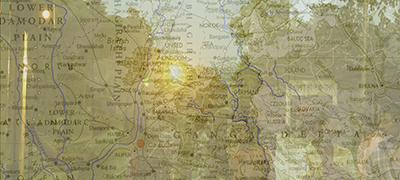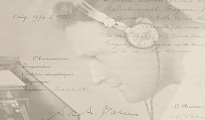This archive within an archive, which holds recordings, images, maps and text, comes out of my doctoral research entitled ‘Songs of Absence and Presence: Listening to the Arnold Bake Wax Cylinder Recordings from Bengal, 1931-34’, submitted in July 2021 and awarded by the School of Cultural Texts and Records, Jadavpur University in November 2022. It mirrors and complements the thesis, laid out in precisely the same order, chapter by chapter. We go to a chapter from the list below, then to the sub-chapters, like moving from the trunk of an old tree to/along its many branches.
I have many to thank for the massive amounts of work which went into the making of each of these chapters and sub-chapters. Arijit Mitra and Purba Rudra primarily, for the banners, design, layout and so much more. The banner of Broken Bengal is a painting by আনখ সমুদ্দুর (Labani Jangi). Agniswar Chakraborty did the main backend work, I know nothing about such things but knew I could depend on him.
Moushumi Bhowmik, 2021
This branches out into two sub-chapters, ‘Absence and Presence’ and ‘Preparation for the Field’. Together, they create the context for this research.
In the thesis Santiniketan and Others is in two chapters, to be read in a flow, but here I present eleven sub-chapters on many of the people Bake recorded in and around Santiniketan, going into some enchanting worlds where the songs and singers take us.
This chapter is made of ten sub-chapters, covering various aspects of Arnold Bake’s love for Bengal’s kirtan, recordings he made, lessons he took, songs he performed, going from places where he had been to places where he wanted to go but could not, and to other places (and people) where I went following his trail.
This chapter is made of two parts. One, of recordings we made in Dumka in 2017, of communities of listeners responding to Bake’s Santal recordings. The other is of informed listeners outside of Dumka, listening later, not only to Bake’s recordings, but also to The Travelling Archive’s, made, while studying Bake in Dumka.
I travelled again and again to Naogaon, over several years, in search of the Naogaon fakirs whom Arnold Bake had recorded. This chapter unfolds as a series of recordings from different stages of this journey, creating a sense of an ongoing search, leading to some amazing discoveries.
In this chapter I am trying to listen to a puthi-path or ‘melodic reading’ recording made in 1918 in a German POW camp, by the linguist Wilhelm Doegen. The puthi was read by a prisoner from Mymensingh. This chapter breaks up into little chapters which are all about learning to listen to the puthi, and later to another narrative song from the same region, the jari. Arnold Bake had recorded jarigan from Mymensingh in 1932.
This chapter is about a lost and found voice of a Sylheti sailor Bake had recorded on board his Europe-bound ship in 1934. I carried this voice to his home, after travelling through places and placenames. I went in search of the other sailors too who were on that ship, whom Bake had recorded. I did not find them but found other stories.
In 1956, Arnold and Corrie Bake came to India for the last time. Now Bengal was partitioned and the land was broken. Bake made some recordings on magnetic tape with a reel-to-reel machine. These recordings led me through a series of excavation, where the recordings themselves become the ground under which lie buried stories and sounds of unknown histories.
There is no such chapter in the thesis, but this archive ends with a song, a composition of mine and a story, sung by me, in an attempt to bring out the archive into the streets today, in our time.



